Phone lens adapters aren't universal due to the wide variety of smartphone models and camera designs. You'll find that different phones have unique camera placements, lens configurations, and body shapes, making it challenging to create a one-size-fits-all solution. Manufacturers often develop proprietary mounting systems for specific brands or models to guarantee ideal fit and image quality. The rapid pace of technological advancements in smartphone cameras further complicates standardization efforts. Additionally, considerations like compatibility with phone cases and the need for precise optical alignment contribute to the diversity of adapter designs. Exploring the intricacies of this complex ecosystem will reveal the full scope of the challenge.
Different Phone Models and Sizes
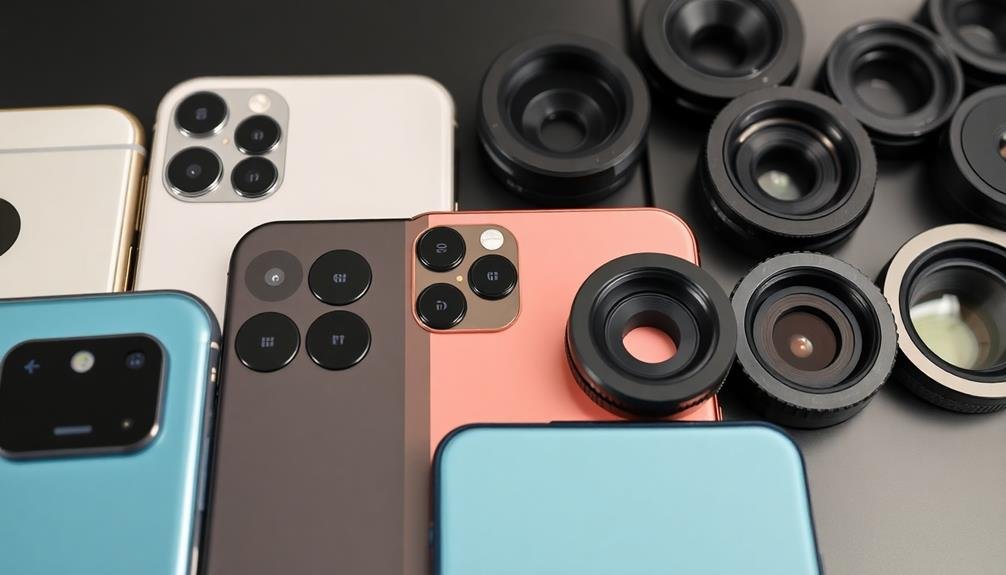
Compatibility is key when it comes to phone lens adapters. You'll find that phone manufacturers constantly release new models with varying sizes, shapes, and camera configurations. This diversity makes it challenging for lens adapter companies to create a one-size-fits-all solution.
Consider the differences between iPhones and Android devices. iPhones typically have a consistent camera placement across models, but Android phones vary widely. Even within a single brand, like Samsung or Google, you'll notice significant changes in camera positioning and size from one model to the next.
The thickness of your phone case adds another layer of complexity. Some adapters might fit perfectly on a naked phone but won't work with a case. Others are designed to accommodate cases but may be too loose without one.
Camera bumps and multiple lenses further complicate matters. As phones incorporate more advanced camera systems, the layout and protrusion of lenses change. This evolution means that an adapter designed for a single-lens phone may not work with a triple-lens setup.
To address these challenges, many manufacturers create model-specific adapters or adjustable systems. However, this approach often results in a trade-off between universality and ideal fit.
Varying Camera Placement and Design
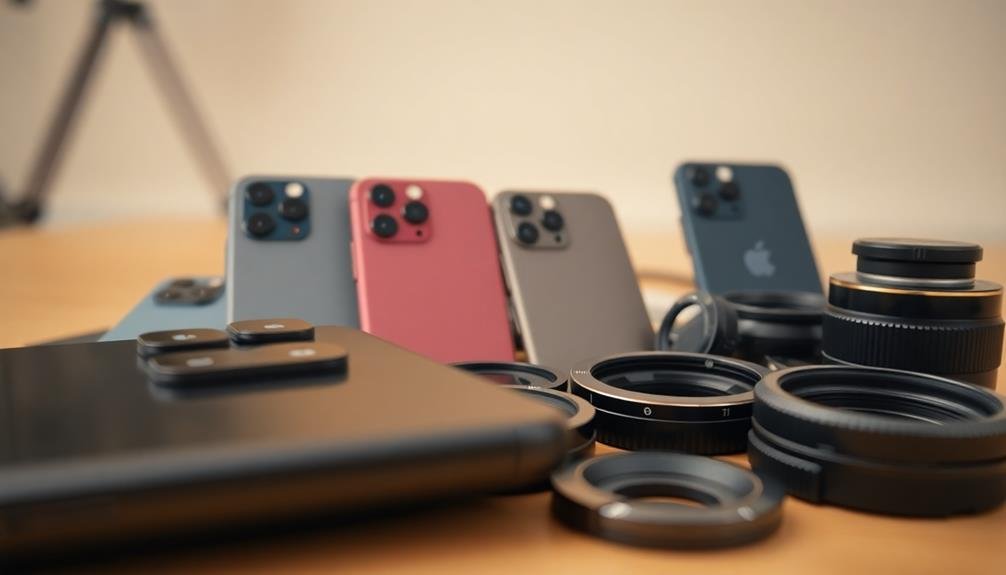
Across the smartphone landscape, camera placement and design vary considerably, presenting a challenge for lens adapter manufacturers. You'll find cameras positioned in different locations on the back of phones, from centered to corner-mounted, and even arranged in various patterns for multi-lens setups.
Some phones feature a camera bump, while others have a flush design. The size and shape of camera lenses also differ between models. You might encounter circular, square, or rectangular lens cutouts, each requiring a unique adapter design.
Additionally, the distance between multiple lenses can vary, affecting how clip-on adapters fit. Front-facing cameras add another layer of complexity. They may be housed in notches, punch-holes, or even pop-up mechanisms, each demanding a different approach for lens attachment.
These variations mean that a lens adapter designed for one phone model likely won't fit another. Manufacturers must create specific adapters for each phone or develop adjustable systems that can accommodate a range of designs.
This diversity in camera configurations is a primary reason why you can't find a truly universal phone lens adapter on the market.
Lens Types and Mounting Systems
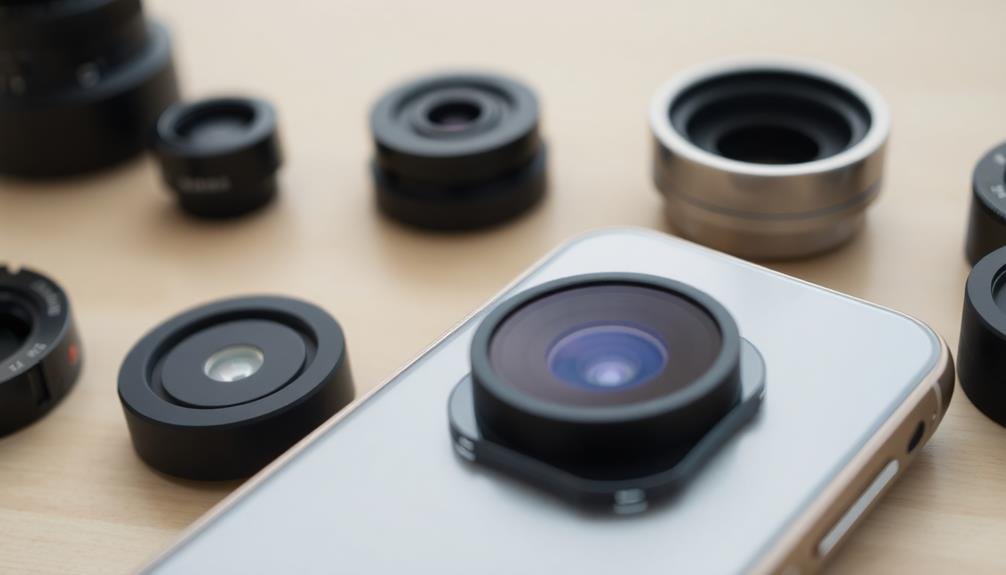
You'll encounter a variety of lens mounts when exploring phone lens adapters, as manufacturers often develop proprietary mounting systems.
These unique designs can make it challenging to find compatible lenses for your specific smartphone model.
Camera module differences between phone brands and models further complicate the selection process, requiring you to carefully match adapters to your device's specifications.
Variety of Lens Mounts
Photographers exploring phone lens adapters will encounter a diverse landscape of lens mounts and systems. You'll find that different manufacturers use their own proprietary designs, which can be frustrating when you're trying to mix and match equipment.
Some popular lens mount types you'll come across include bayonet mounts, screw-on mounts, and clip-on mounts. Bayonet mounts use a twisting motion to secure the lens, while screw-on mounts thread directly onto the phone case or adapter. Clip-on mounts, as the name suggests, clip over your phone's camera lens.
You'll also notice that lens mounts can vary based on phone models. An adapter designed for an iPhone 12 mightn't fit an iPhone 13 due to slight changes in camera placement or phone dimensions. Additionally, Android phones from different manufacturers will likely have incompatible mounting systems.
Some companies have tried to create more universal solutions. For example, you might find adapters with adjustable grips that can fit various phone sizes.
However, these often sacrifice stability or optical alignment for versatility. As a result, you'll need to carefully consider your specific phone model and desired lenses when choosing an adapter system.
Proprietary Mounting Systems
Manufacturers often develop their own proprietary mounting systems for phone lens adapters, creating a fragmented market. You'll find that companies like Moment, Olloclip, and ShiftCam have designed unique attachment mechanisms for their lenses. These systems are engineered to fit specific phone models or cases, ensuring a secure and precise connection.
While proprietary mounts can offer excellent stability and optical alignment, they limit your options as a consumer. You're often locked into a single brand's ecosystem, unable to mix and match lenses from different manufacturers. This exclusivity can be frustrating if you want to try various lens types or upgrade your phone without replacing your entire lens collection.
Some companies use magnetic mounts, clip-on systems, or specialized cases to attach their lenses. Others may require you to adhere a mounting plate to your phone. Each approach has its pros and cons, affecting factors like ease of use, lens swapping speed, and phone protection.
When choosing a lens system, you'll need to weigh these factors against the quality and variety of lenses offered by each brand.
Camera Module Differences
Beyond proprietary mounting systems, the diversity of smartphone camera modules presents another challenge for lens adapter manufacturers. You'll find that different phone models use various lens types, sizes, and configurations. Some phones have a single camera, while others boast multiple lenses for wide-angle, telephoto, or macro shots.
These differences in camera modules mean that lens adapters must be designed specifically for each phone model. The adapter needs to align perfectly with the phone's built-in lens to avoid vignetting or distortion. It must also account for the sensor size and focal length of the phone's camera.
Additionally, the positioning of the camera module on the phone's body varies between models. Some phones have centrally located cameras, while others position them in the corner. This affects how the adapter attaches to the phone and interacts with its case or other accessories.
As manufacturers continue to innovate with camera technology, you'll see even more variations in lens types and arrangements. This ongoing evolution makes it challenging to create a truly universal lens adapter that works across all smartphone models.
Manufacturer-Specific Adapters and Accessories
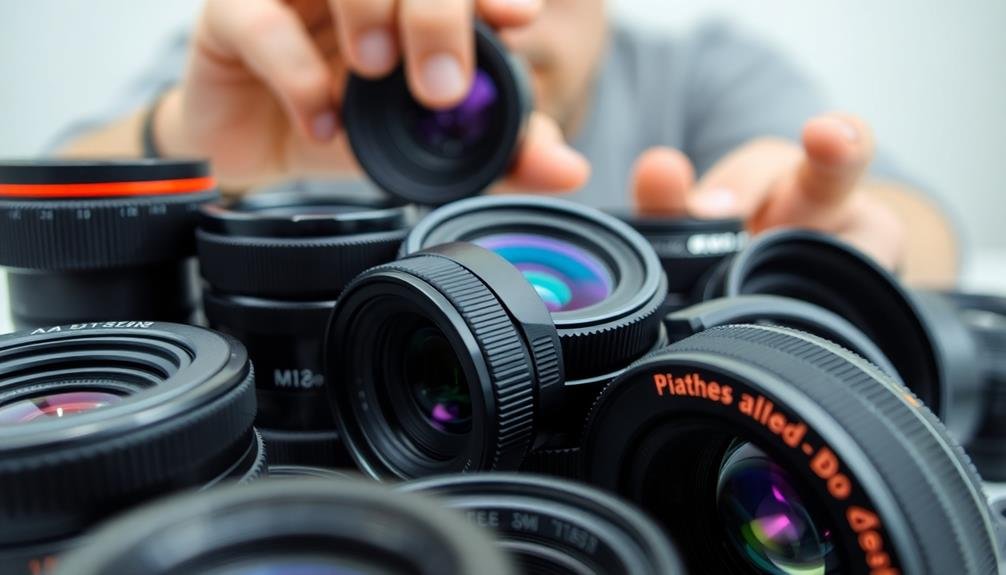
When shopping for phone lens adapters, you'll encounter manufacturer-specific options designed for particular smartphone brands.
These proprietary mounting systems guarantee a perfect fit and ideal performance with your device's camera.
Brand-specific lens designs often offer seamless integration with native camera apps and may include exclusive features tailored to certain phone models.
Proprietary Mounting Systems
In the domain of phone lens adapters, proprietary mounting systems play a significant role. These systems are designed by manufacturers to work exclusively with their own products, creating a closed ecosystem. You'll find that many popular brands have developed unique mounting mechanisms to attach lenses to smartphones.
Proprietary systems offer both advantages and drawbacks. They guarantee a perfect fit and ideal performance with the manufacturer's devices but limit your options for third-party accessories. You're often locked into a specific ecosystem, which can be frustrating if you want to mix and match components from different brands.
Here's a comparison of some popular proprietary mounting systems:
| Brand | Mounting Type | Compatibility | Lens Options |
|---|---|---|---|
| Moment | Bayonet | Limited | Wide range |
| Olloclip | Clip-on | Phone-specific | Moderate |
| RhinoShield | Twist-lock | Brand-specific | Growing |
| ShiftCam | Slide-on | Limited | Extensive |
When choosing a phone lens adapter, consider the long-term implications of investing in a proprietary system. While it may offer superior integration with your current device, it could limit your future choices if you switch phone brands or want to explore other lens options.
Brand-Specific Lens Designs
Several major smartphone manufacturers have developed their own brand-specific lens designs and accessories. These proprietary systems are tailored to work seamlessly with their specific phone models, offering enhanced functionality and integration.
For example, Apple's MagSafe system allows for magnetic attachment of lenses and other accessories, while Samsung's Galaxy phones often feature specialized lens adapters designed exclusively for their devices.
When you're looking to expand your phone's photography capabilities, you'll find that these brand-specific lens designs can offer advantages. They're engineered to perfectly fit your device, ensuring ideal alignment with the built-in camera. This precision can result in better image quality and reduced issues like vignetting or distortion.
However, the downside is that you're limited to accessories made specifically for your phone's brand and model. This can be frustrating if you switch between different phone brands or want to use a particular lens that isn't available for your device.
It also means that when you upgrade your phone, you may need to replace your entire collection of lenses and adapters, which can be costly and wasteful.
Rapid Technological Advancements
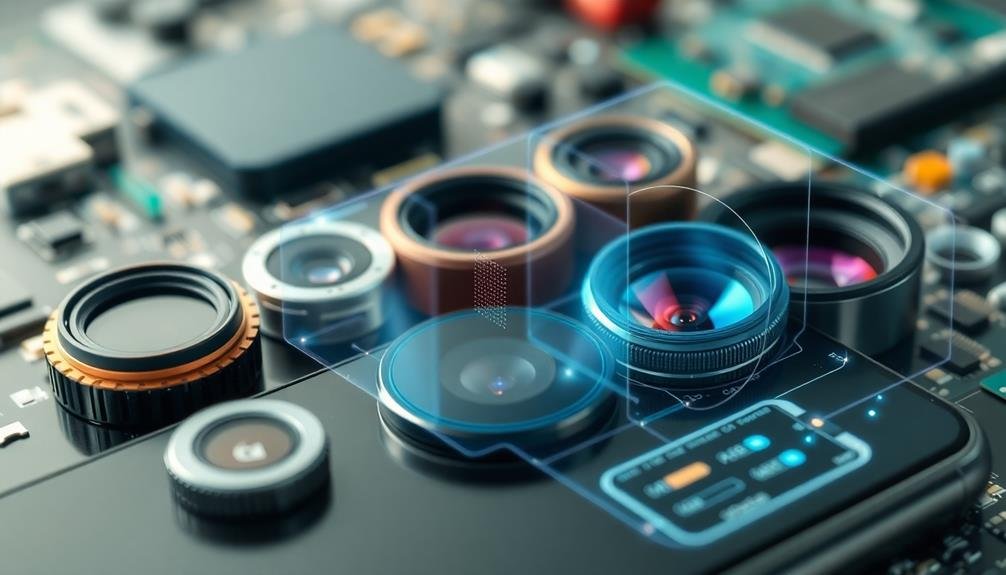
Rapid technological advancements have revolutionized the world of smartphone photography. You'll notice that phone manufacturers are constantly updating their camera systems, introducing new features, and improving image quality. This fast-paced evolution makes it challenging for lens adapter makers to keep up.
As new phone models are released, their camera configurations often change. You might find that the position, size, or number of lenses on the back of your phone differs from previous versions. This constant flux means that lens adapters designed for one model may not fit the next.
Here's a quick look at how rapid advancements affect lens adapter compatibility:
| Advancement | Impact on Lens Adapters |
|---|---|
| New sensors | May require different optics |
| Multi-lens arrays | Need for precise alignment |
| Larger apertures | Adapters must accommodate size |
| Software improvements | Potential incompatibility issues |
You'll also find that as phone cameras become more sophisticated, the need for external lenses diminishes. Many features that once required additional hardware are now built-in or achieved through software. This shifting landscape makes it difficult for manufacturers to create truly universal lens adapters that remain relevant across multiple phone generations.
Cost Considerations for Manufacturers
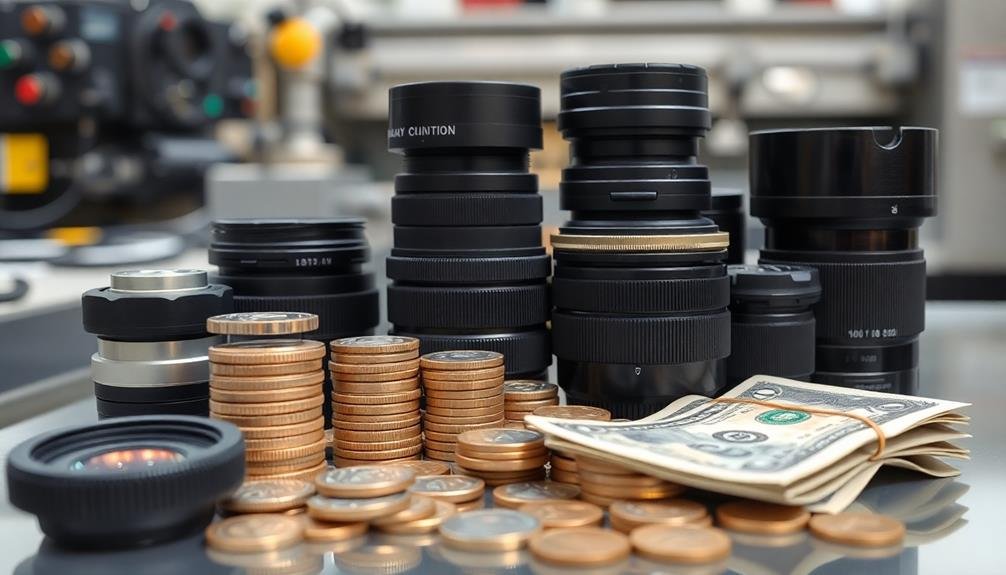
Manufacturers of phone lens adapters face significant financial challenges in this ever-changing market. They must constantly invest in research and development to keep up with new phone models and camera configurations. This ongoing process requires substantial resources, driving up production costs and, ultimately, retail prices.
Creating universal adapters that fit all phone models isn't economically viable for most manufacturers. The wide variety of phone designs and camera placements means that producing a truly universal adapter would be complex and expensive. Instead, companies often focus on creating adapters for popular models to maximize their return on investment.
Consider these cost-related factors that influence manufacturers' decisions:
- Tooling and production setup costs for each new adapter design
- Inventory management expenses for multiple adapter models
- Marketing and distribution costs for various product lines
You'll find that manufacturers must balance the desire for universality with practical business considerations. They often choose to produce adapters for specific phone models or brands, targeting the most lucrative market segments. This approach allows them to maintain profitability while still offering quality products to consumers, even if it means sacrificing universal compatibility.
Compatibility With Phone Cases
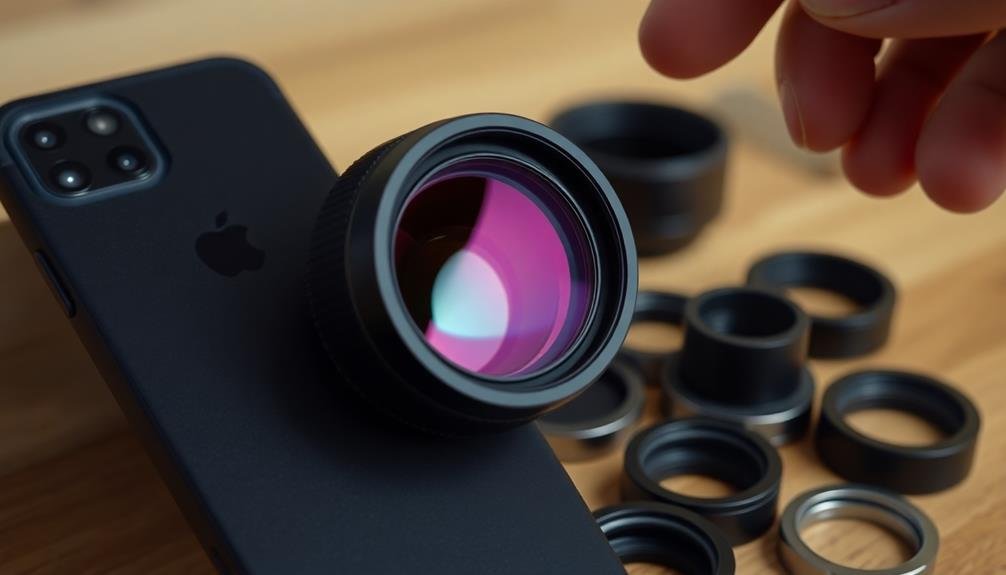
Guaranteeing compatibility with phone cases presents a significant challenge for lens adapter manufacturers. You'll find that most users want to keep their protective cases on while using lens attachments, but this creates a design hurdle.
The thickness and shape of phone cases vary widely, making it difficult to create a one-size-fits-all solution.
When you're shopping for a lens adapter, you'll notice that some require you to remove your case, while others offer limited case compatibility. Manufacturers often design adapters to work with specific popular case models or their own branded cases. This approach guarantees a secure fit but limits your options.
You might encounter clip-on adapters that attempt to solve this problem by fitting over various case thicknesses. However, these can be less stable and may not align perfectly with your phone's camera.
Some companies have started producing modular systems that allow you to adjust the adapter's depth to accommodate different cases. While this improves versatility, it also adds complexity and cost to the product.
Ultimately, the wide variety of phone cases on the market makes universal compatibility a tough goal to achieve for lens adapter manufacturers.
Optical Alignment and Image Quality
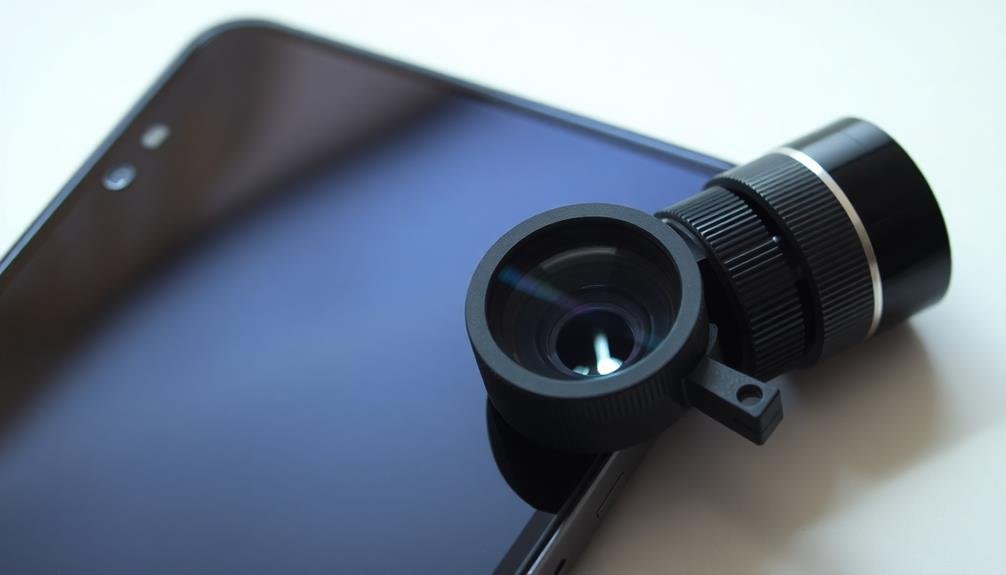
When it comes to phone lens adapters, optical alignment and image quality are critical factors that can make or break your photography experience.
These adapters must be precisely engineered to guarantee that the additional lens aligns perfectly with your phone's camera. Even a slight misalignment can result in distorted images, vignetting, or loss of sharpness.
The quality of the adapter's materials and construction directly impacts the final image. Cheap adapters may use low-grade optics that introduce chromatic aberration or reduce light transmission, compromising your photos.
Additionally, the adapter's design must account for the specific characteristics of your phone's camera, including its focal length and sensor size.
To achieve the best results when using phone lens adapters:
- Research adapters specifically designed for your phone model
- Invest in high-quality adapters from reputable manufacturers
- Carefully align the adapter each time you attach it to your phone
Remember that universal adapters often sacrifice ideal alignment and image quality for compatibility.
Market Demand and Consumer Preferences
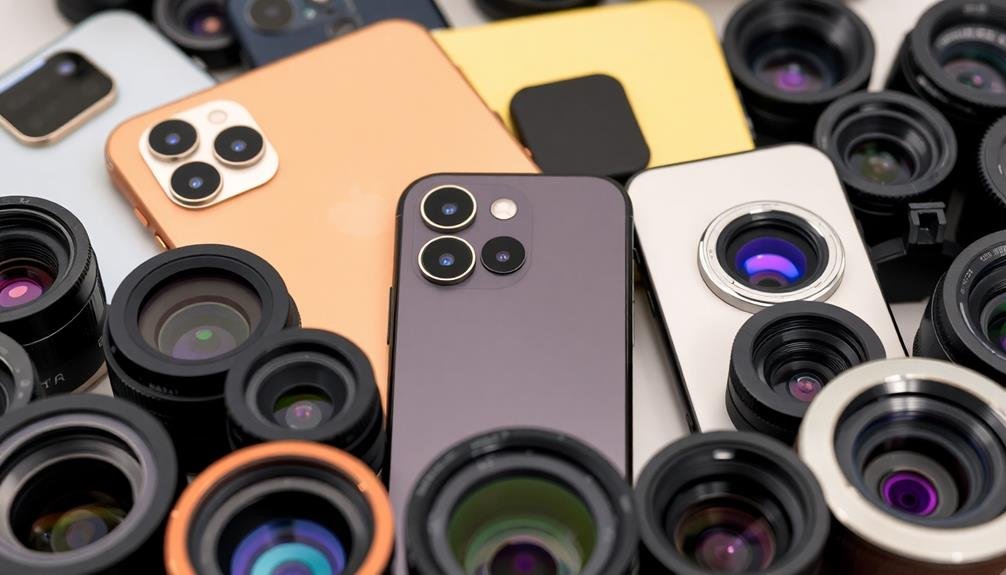
The surge in smartphone photography has sparked a growing demand for phone lens adapters. You'll find that consumers are increasingly looking for ways to enhance their mobile photography experience without investing in expensive camera equipment. This trend has led to a diverse market of lens adapters catering to various preferences and needs.
When choosing a lens adapter, you'll consider factors such as compatibility, ease of use, and image quality. Here's a breakdown of consumer preferences:
| Feature | Importance | Trend |
|---|---|---|
| Compatibility | High | Multi-device support |
| Image Quality | High | Professional-grade optics |
| Portability | Medium | Compact, clip-on designs |
You'll notice that manufacturers are responding to these preferences by developing more versatile and user-friendly adapters. Some focus on creating universal designs that fit multiple phone models, while others specialize in high-end optics for specific flagship devices.
As the market evolves, you'll see a shift towards modular systems that allow you to swap lenses easily. This flexibility appeals to both casual users and enthusiasts, driving the continued growth of the phone lens adapter market.
Standardization Challenges in the Industry
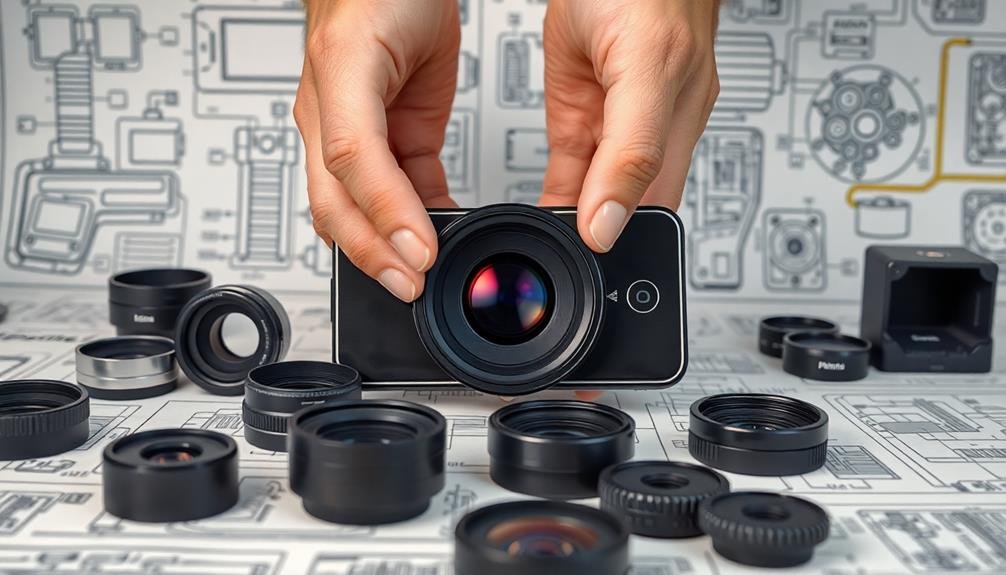
While consumer preferences drive innovation in phone lens adapters, the industry faces significant hurdles in standardization. You'll find that manufacturers often create proprietary designs to fit specific phone models, making it challenging to develop universal adapters. This fragmentation leads to a market flooded with countless options, each tailored to particular devices or brands.
The rapid pace of smartphone evolution further complicates standardization efforts. As phone designs change frequently, lens adapter manufacturers must constantly update their products to remain compatible. This cycle of innovation and adaptation makes it difficult to establish long-lasting industry standards.
To better understand the standardization challenges, consider these key factors:
- Diverse camera configurations across phone brands and models
- Varying sizes and shapes of smartphone bodies
- Proprietary mounting systems developed by different manufacturers
You'll notice that these obstacles create a complex ecosystem where universal compatibility remains elusive. As a consumer, you're often left to navigate a maze of options, hoping to find the right adapter for your specific device.
The industry's struggle with standardization directly impacts your ability to easily find and use phone lens adapters across different smartphone models.
Frequently Asked Questions
Can Lens Adapters Affect a Phone's Warranty?
Yes, lens adapters can affect your phone's warranty. If you're not careful, they might damage your device's camera or body. It's best to check your warranty terms or contact the manufacturer before using any third-party accessories.
Are There Universal Lens Adapters for Specific Phone Brands?
You'll find some universal lens adapters for specific phone brands, but they're not common. Most adapters are designed for particular models due to varying camera placements and sizes. It's best to check compatibility before purchasing any adapter.
How Do Lens Adapters Impact a Phone's Water Resistance?
When you attach a lens adapter to your phone, it can compromise the water resistance. You'll often need to remove protective cases, exposing ports and seals. It's best to avoid water exposure when using lens adapters on your device.
Can Lens Adapters Interfere With a Phone's Wireless Charging Capabilities?
Yes, lens adapters can interfere with wireless charging. If you're using a metal adapter or one that's too thick, it might disrupt the magnetic field needed for charging. It's best to remove the adapter before placing your phone on a wireless charger.
Are There Safety Concerns When Using Third-Party Lens Adapters?
You should be aware of potential safety concerns with third-party lens adapters. They may not fit securely, causing damage to your phone or camera. Low-quality materials could scratch your device or produce poor images. Always research before purchasing.
In Summary
You've seen how phone lens adapters aren't universal due to various factors. From different phone models and camera designs to manufacturer-specific accessories and rapid tech advancements, it's a complex landscape. You'll find that standardization challenges and varying consumer preferences further complicate the issue. As you explore lens adapters, remember that compatibility with your specific phone model and case is essential for peak performance and image quality.





Leave a Reply